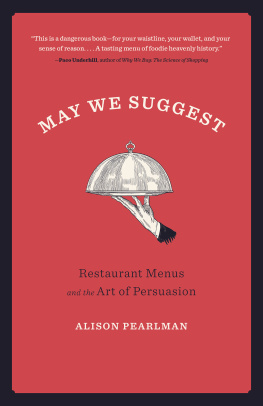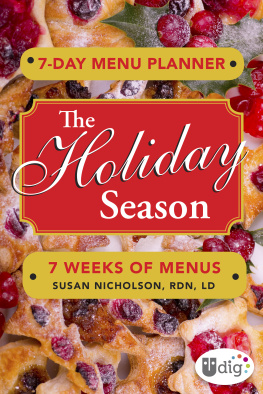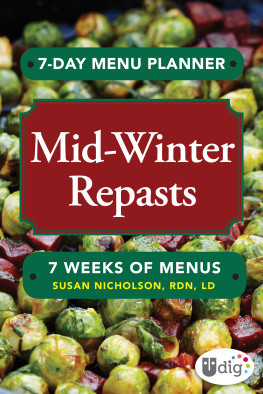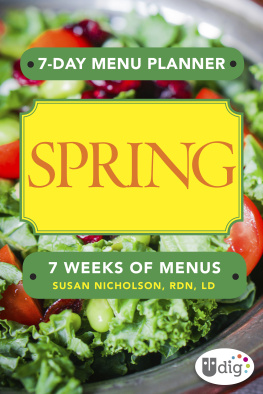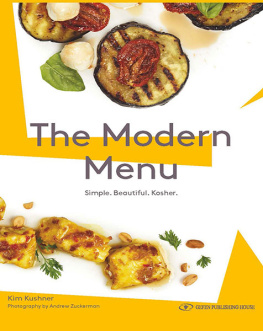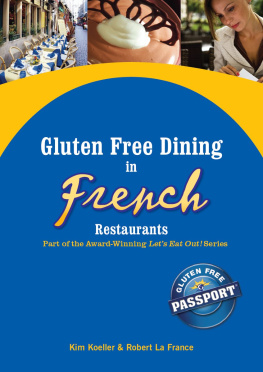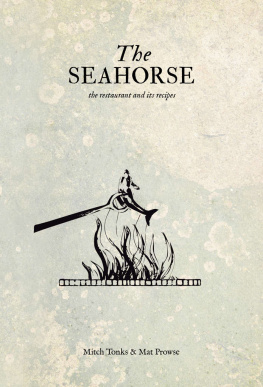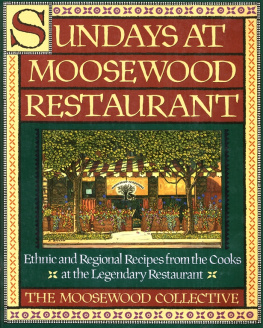
MAY WE SUGGEST
MAY WE SUGGEST

Restaurant Menus and the Art of Persuasion
ALISON PEARLMAN

Copyright 2018 by Alison Pearlman
All rights reserved. No part of this book may be reproduced or transmitted in any form or by any means, electronic or mechanical, including photocopying, recording, or by any information storage and retrieval system, without express written permission from the publisher.
Printed in the United States of America
Library of Congress Cataloging-in-Publication Data
Names: Pearlman, Alison, author.
Title: May we suggest : restaurant menus and the art of persuasion / Alison Pearlman.
Description: Chicago : Surrey Books, an Agate Imprint, [2018] | Includes bibliographical references and index.
Identifiers: LCCN 2018021593 (print) | LCCN 2018024199 (ebook) | ISBN 9781572848221 (e-book) | ISBN 1572848227 (e-book) | ISBN 9781572842601 (pbk.) | ISBN 9781572848221 (eISBN)
Subjects: LCSH: Gastronomy. | Cooking. | Menus. | Restaurants.
Classification: LCC TX633 (ebook) | LCC TX633 .P32 2018 (print) | DDC 641.5--dc23
LC record available at https://lccn.loc.gov/2018021593
First Printing: October 2018
10 9 8 7 6 5 4 3 2 118 19 20 21 22
Surrey Books is an imprint of Agate Publishing. Agate books are available in bulk at discount prices. For more information, visit agatepublishing.com.
In memory of my dear father,
Daniel David Pearlman
(19352013)
This is the first book of mine he wasnt able to read drafts of, or offer, as he always did, with gentleness and patience, his incisive suggestions for editing. I only hope that I was able to learn enough from his example that I could apply something of his eye to these pages, and that I may one day, in exercising what he taught me since the time I looked up at him as a giant in the house, achieve a fraction of his wit and mastery of structure, qualities he so emphatically displayed in his genre-bending and often side-splittingly funny works of fiction, novels such as Black Flames (1997) and Memini (2003); the 2011 novella, Brain & Breakfast (one of my favorites!); and treasure troves of short stories, including The Final Dream & Other Fictions (1995), The Best Known Man in the World & Other Misfits (2001), and A Giant in the House & Other Excesses (2011)all ideal introductions to his impressive range. The many short stories he contributed to anthologies are also well worth your while to track down.
CONTENTS
INTRODUCTION
IM WRITING A BOOK ABOUT RESTAURANT MENUS. COULD I ASK YOU some questions about the design of your menus? I blurted, seizing the chance after dinner on the way out to meet Sarintip Singsanong, a.k.a Jazz, then co-owner and front-of-the-house maestro of Jitlada. Cheerfully checking on guests in the two small, but full, dining rooms, the practiced host had not stopped moving.
I knew I wouldnt throw her. Jazz was used to inquiring writers. Jitladas accolades for best Thai in Los Angeles, blessings by critic Jonathan Gold, and more articles about the place were hard to miss under the glass tops of the dining-room tables and in the otherwise modest front window. Part of a Colman Andrews feature in Gourmet was the About text for the restaurant on its website.
Jazz beamed and immediately steered me outside to meet her (now late) brother (also co-owner at the time) Suthiporn Sungkamee, or Chef Tui. It was 11:00 p.m., just after the dinner rush, and Chef Tui sat in a chair looking out over the strip-mall parking lot on a Thai Town slice of Sunset Boulevard. He was still aproned but taking a well-earned respite. Jazz insisted, Hes the man to speak to about the menu.
Did the chef design the menu pages? I wondered, not sure Jazz understood. I traced a rectangle in the air with my fingers to specify what I called the design of the physical menu. No matter. They both began speaking with passion about Jitladas food.
Who could blame them for thinking that, by menu, I meant food? The word menu is ambiguous, after all. It can refer to the dishes on a bill of fare, not the artifact itself. Whats more, Jazz and Chef Tui were justifiably proud of their cuisine, honed by the chefs more than fifty years of experience. Finally, judging by their media coverage, Jazz and Chef Tui werent used to fielding questions about the art of menu design.
And yet, their nine-page documentwhich overflowed, by the way, onto a glow-in-the-dark board with another list of handwritten specialswas part of what made Jitlada exceptional. The menu was notoriously long. That night I counted 252 items just on the main menu. Ive seen longer lists in Chinese restaurants, but Jitladas was a contender even among those. It was long enough to have inspiredindirectly, at leasta feature in the Los Angeles Times. In 2011, food blogger Jo Stougaard made news by challenging herself to eat every dish on the list.
Furthermore, the menu lookedif not graphically hip or crafted by professional menu consultantsmethodical. The prices, for example, were all expressed as X.95, whether a dish was $5.95 or $64.95. The listing for Crying Tiger, a dish so-named because your choice of beef or pork would be eye-watering if you poured on too much of the accompanying chili sauce, mentioned that the dish was featured on Food Networks Best Thing I Ever Ate show. Also, the listings were selectively redundant. Several dishes from the main menu repeated on a list that stood on the table in a clear plastic standa table tent, in industry parlance. It didnt seem random, either, that the word spicy in the phrase spicy smoothies was the only one in bright red. Collectively, these features showed at least a little thought and definitely a conviction that how a menu communicates matters.
A few days later, I clarified what I was after and Jazz generously answered questions about the physical menu. But she and Chef Tui would not be the only restaurateurs with whom I had the same miscommunication at first.
Without meaning to, restaurant critics make such misunderstandings more likely. How often have you read a review that seriously discussed the artistry of the menu? Readers want to learn about the food, the service, the setting, and the overall dining experience, so they can decide if they want to patronize a place. Reviewers seldom have the space to elaborate, as I shall in this book, how the menu, like an operating manual, is the thing that coordinates them all.
I didnt always analyze menus. For decades as a restaurant diner, I related to them mainly on emotional and personal terms.
On a rare trip with my mother and stepfather to Europe as a teen in 1985, I began collecting menus from restaurants that stirred my imagination. My mothers clippings from Gourmet ensured us a succession of impressive restaurant outings, and the permanence of menus compensated in part for those fleeting meals.
I already had a fondness for restaurants. My mother and stepfathers habit of trying new places with me in tow in San Francisco, where I lived most of the year, gave dining out an air of aesthetic adventure. So did the exposure my stepmother and father gave me in the summer to diners, roadhouses, Sun Valley surf and turf, and old New England taverns and chowder institutions over the years they lived in Idaho and Rhode Island. Establishments they brought me to on sojourns to Manhattan after their move east also amazed me. My stepmother planned our escapades in culinary culture high, low, and ethnically eye-opening. Wed go from the bohemian El Faro in Greenwich Village (now closed), where dusky murals of flamenco dancers had held on to memories of smoke-filled nights since 1927, to the dapper (and also no more) Le Train Bleu, the signature restaurant in Bloomingdales designed to look like a first-class railroad dining car.
Next page
